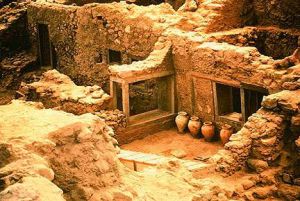 About Us
About Us  Embassy of Greece in London
Embassy of Greece in London  News
News  Akrotiri archaeological site posts 1,300 visitors daily since reopening
Akrotiri archaeological site posts 1,300 visitors daily since reopening
Akrotiri archaeological site posts 1,300 visitors daily since reopening

The Akrotiri archaeological site on the island of Santorini which reopened on April 11 after remaining closed for more than 6 1/2 years following the collapse of a steel roof that claimed the life of a UK tourist and injured six other visitors, has attracted droves of visitors in the six months since its reopening, reaching up to 1,300 people on some days.
A new bio-climatic roof of stainless steel and wood has replaced the collapsed roof. Designed by architect Nikos Fintikakis, the new roof ensures zero energy consumption, which renders it a unique energy conservation project on such a large scale internationally. The specially designed openings at north and south ensure circulation of air during the night hours so that the site is cooled naturally, while during the daytime they allow the sun's rays in so as to provide natural lighting of the site.
The paths for the visitors follow, as a rule, the routes of the ancient streets, while a special route has been designed for people with a disability.
Akrotiri is one of the most important prehistoric settlements of the Aegean. The first habitation at the site dates from the Late Neolithic times (at least the 4th millennium B.C.). During the Early Bronze Age (3rd millennium B.C.), a sizeable settlement was founded and in the Middle and early Late Bronze Age (ca. 20th-17th centuries B.C.) it was extended and gradually developed into one of the main urban centers and ports of the Aegean.
The large extent of the settlement (approx. 20 hectares), the elaborate drainage system, the sophisticated multi-storied buildings with the magnificent wall-paintings, furniture and vessels, show its great development and prosperity.
The various imported objects found in the buildings indicate the wide network of its external relations. Akrotiri was in contact with Crete but also communicated with the Greek Mainland, the Dodecanese, Cyprus, Syria and Egypt.
The town's life came to an abrupt end in the last quarter of the 17th century B.C. when the inhabitants were obliged to abandon it as a result of severe earthquakes. There followed the devastating eruption of the island's volcano, known as the Minoan or Thira (Santorini) eruption, one of the largest volcanic events on Earth in recorded history. The volcanic materials covered the entire island and the town itself. These materials, however, have protected up to date the buildings and their contents, just like in Pompeii.
The Akrotiri archaeological site is open to visitors from 8:00 to 17:00.
SOURCE: ATHENS NEWS AGENCY


















